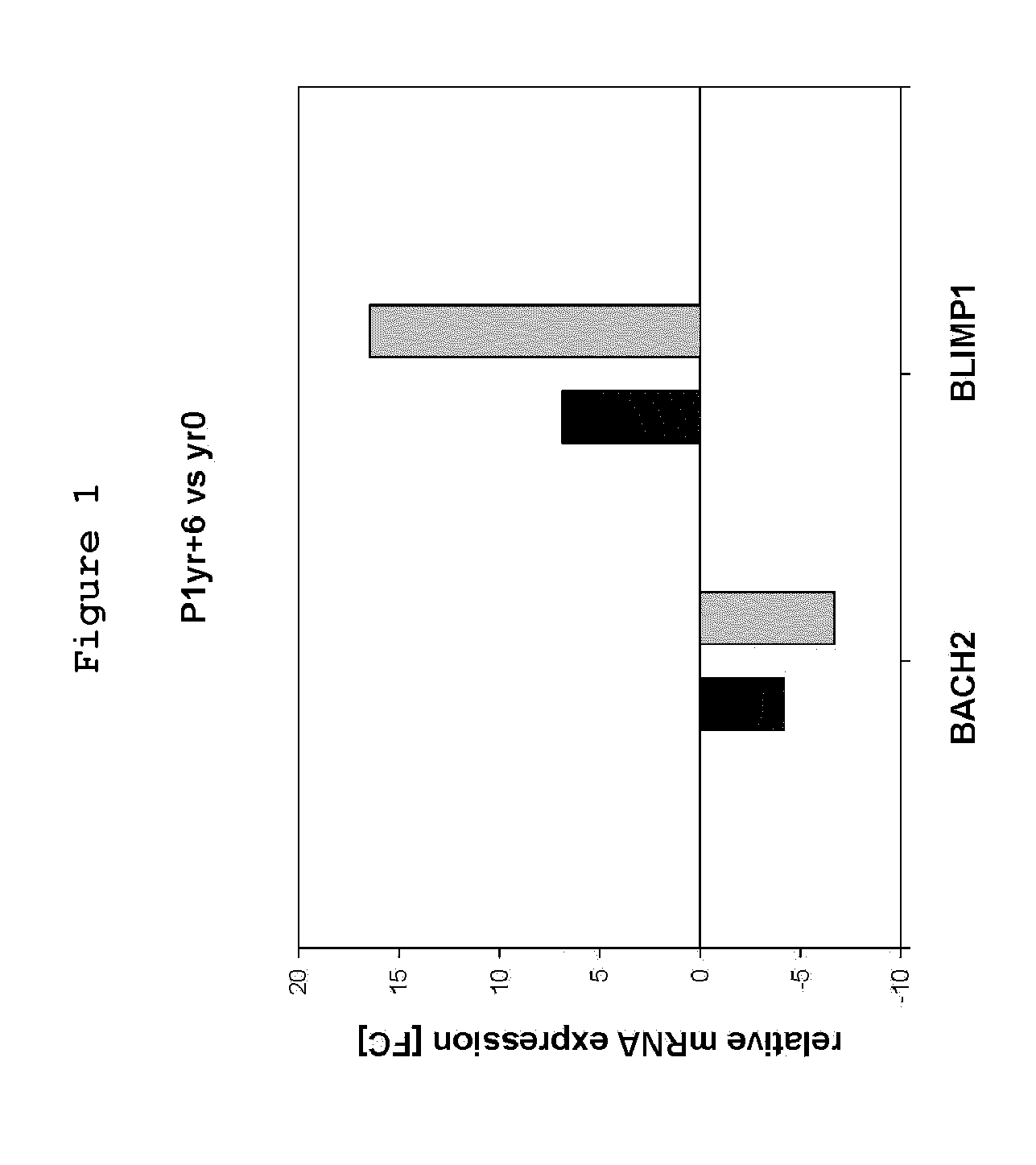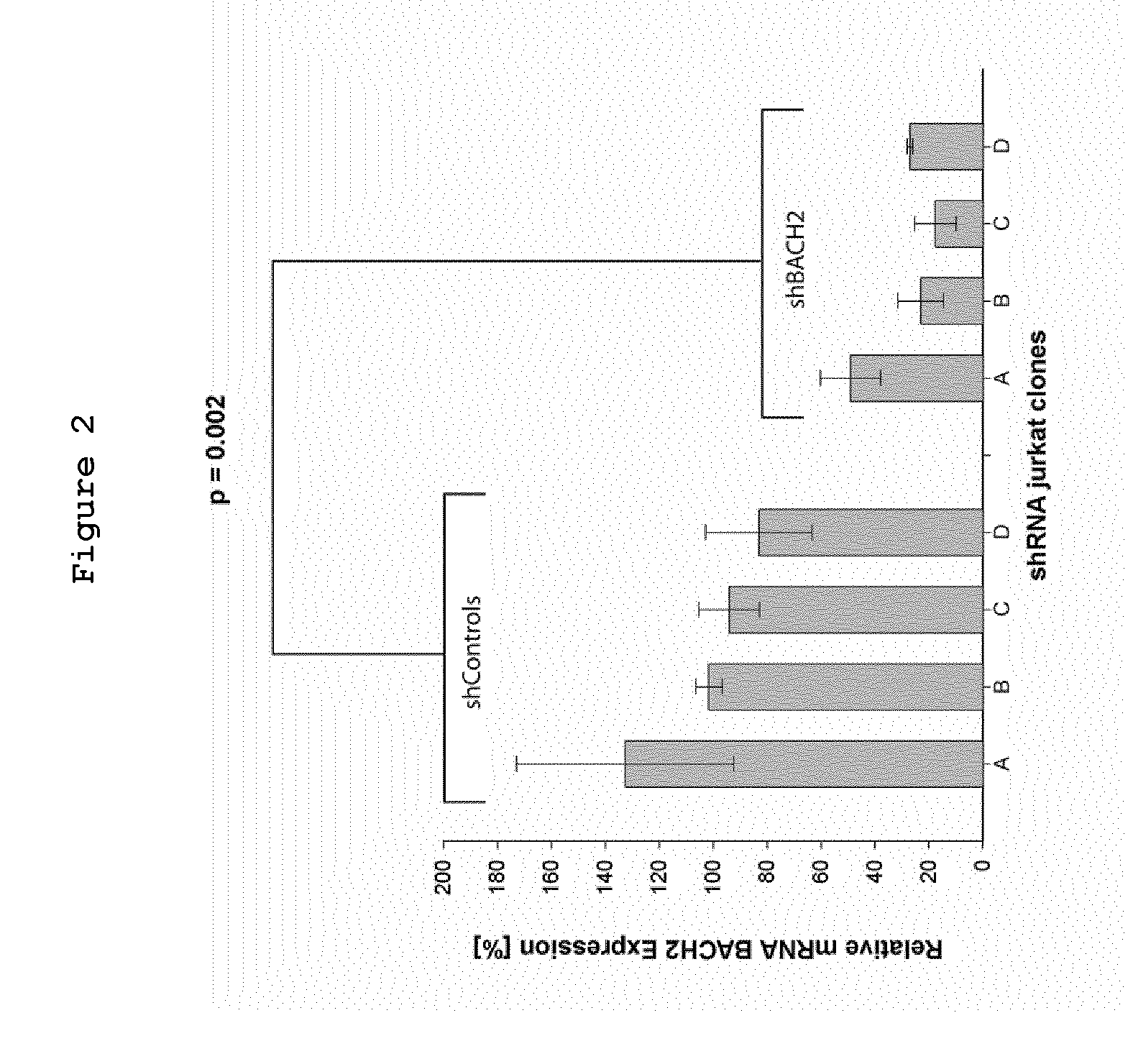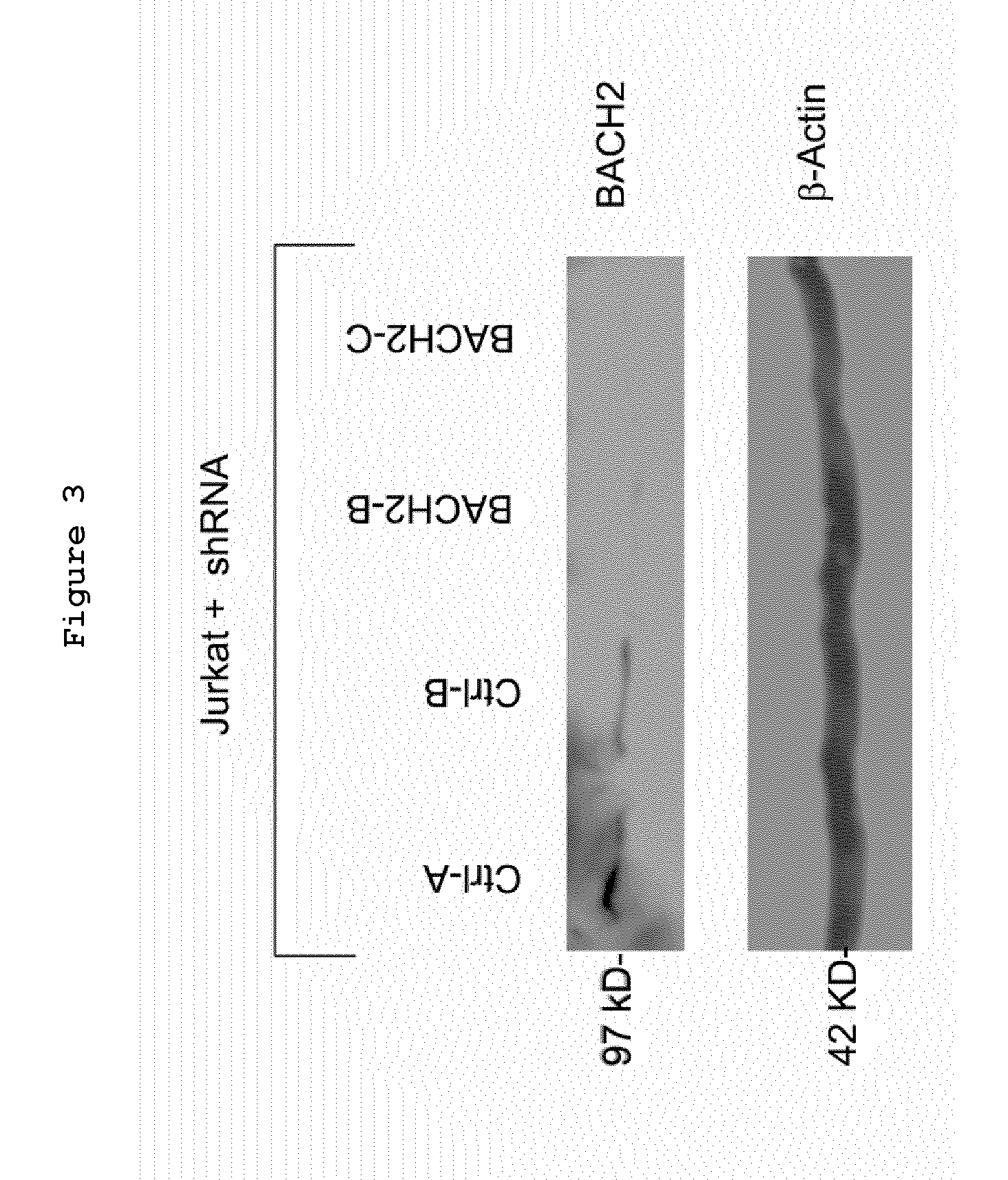Bach2 repression in cells
a cell and bach2 technology, applied in the field of cell proliferation status diagnosis, can solve the problem that no definitive evidence of suppressive activity has been obtained, and achieve the effect of reducing the level of bach2
- Summary
- Abstract
- Description
- Claims
- Application Information
AI Technical Summary
Benefits of technology
Problems solved by technology
Method used
Image
Examples
example 1
[0075]Gene Expression Profile Focused on the 6q13-22.1 Minimal Deleted Region in CD3-CD4+ T Cells from 3 L-HES Patients
[0076]A commonly deleted region located between bands q13 and q22.1 of the long arm of chromosome 6 was previously identified in CD3-CD4+ T cells from 2 L-HES patients (P1 and P2). To complete the genomic characterization of the CD3-CD4+ T cell clone of a third patient (P3), FISH experiments were performed using a 6g15-specific BAC probe. A complete 6q loss was identified in 25% of nuclei of uncultured CD3-CD4+ T cells from patient P3 and found associated with an isochromosome 6p (i(6) (p10;p10)) as confirmed by CGH.
[0077]By comparing the gene expression profiles of CD3-CD4+ T cell clones from 3 L-HES patients with CD3+CD4+ T cells from healthy controls, the inventors have detected 13 repressed genes within the commonly deleted region 6g13-q22.1.
[0078]No enhanced expression was found even in the totality of the long arm of chromosome 6, in contrast to several over-e...
example 2
[0079]Gene Expression Analysis of the 6q13-22.1 Region Extended to a Cohort of 5 Patients L-HES
[0080]The validation of the microarray data was performed for the 13 mentioned genes by real-time quantitative RT-PCR on purified T cells from an enlarged patient cohort of 5 L-HES patients and 5 healthy controls (Table 1).
TABLE 1AverageFoldGeneDCt 5RankAverageRankAverageChangep-valueSymbolCytobandPatients5 PatientsDCt 5 Controls5 Controls2{circumflex over ( )}(−DDCt) 5P vs 5C5P vs 5C5P vs 5CNM_001402.5EEF1A16q13-14−6.64[−9.73:−5.55]−9.06[−9.31:8.87]0.19−5.380.0155NM_00100409.1SENP66q14.11.73[0.91:2.59]−0.09[−0.48:0.38]0.28−3.540.0007NM_004242.2HMGN36q14.11.92[−0.54:4.08]−0.50[−0.72:−0.3]0.19−5.340.0143NM_017633.2FAM46A6q14.15.63[1.88:7.95]2.67[2.33:2.86]0.13−7.730.0192NM_002526.2NT5E6q14.39.38[6.65:11.19]4.94[3.12:6.25]0.05−21.740.0012NM_021244.4RRAGD6q155.98[3.14:7.19]2.53[1.98:2.78]0.09−10.970.0021NM_021813.2BACH26q154.73[2.41:6.83]1.22[0.64:1.66]0.09−11.420.0019NM_01591.1SFRS186q16.3−0...
example 3
[0084]Gene expression of the 6q14.1-22.1 Region during P1 Clinical Evolution
[0085]The chronological profiling of CD3-CD4+ T-cells from P1 was previously described starting at the chronic indolent clinical phase and continuing to the full blown T lymphoma stage.
[0086]The inventors measured over time the progressive changes in expression of the genes contained within the 6q14.1-22.1 region during the disease to understand the transforming steps.
[0087]Of the 11 repressed genes, only BACH2's transcript level was shown significantly and progressively over-repressed when tested by microarray and by real-time quantitative RT-PCR (FIG. 1). In particular, a -1.7 fold additional decrease in BACH2 mRNA level was confirmed between yr 0 and yr+6 corresponding, respectively, to samples taken during the chronic and acute phases of the disease (FIG. 1).
[0088]Of interest, at that advanced stage, BACH2 over-repression was associated with a significant 2.4 fold over-expression of BLIMPI mRNA (microarr...
PUM
| Property | Measurement | Unit |
|---|---|---|
| concentration | aaaaa | aaaaa |
| threshold of | aaaaa | aaaaa |
| Fluorescence | aaaaa | aaaaa |
Abstract
Description
Claims
Application Information
 Login to View More
Login to View More - R&D
- Intellectual Property
- Life Sciences
- Materials
- Tech Scout
- Unparalleled Data Quality
- Higher Quality Content
- 60% Fewer Hallucinations
Browse by: Latest US Patents, China's latest patents, Technical Efficacy Thesaurus, Application Domain, Technology Topic, Popular Technical Reports.
© 2025 PatSnap. All rights reserved.Legal|Privacy policy|Modern Slavery Act Transparency Statement|Sitemap|About US| Contact US: help@patsnap.com



